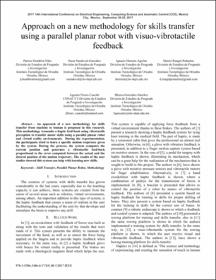| dc.contributor.author | Humblot Niño, Patrice | |
| dc.contributor.author | Herrera Aguilar, Ignacio | |
| dc.contributor.author | Rangel Peñuelas, Daniel | |
| dc.contributor.author | Gonzalez Sanchez, Blanca | |
| dc.contributor.author | Flores Cuautle, Jose de Jesus Agustin | |
| dc.contributor.author | Sandoval Gonzalez, Oscar | |
| dc.date.accessioned | 2022-06-30T03:42:02Z | |
| dc.date.available | 2022-06-30T03:42:02Z | |
| dc.date.issued | 2017-09-20 | |
| dc.identifier.citation | Humblot-niño, P., Herrera-aguilar, I., Rangel-peñuelas, D., Flores-cuautle, A., & González-sánchez, B. (2017). Approach on a new methodology for skills transfer using a parallel planar robot with visuo-vibrotactile feedback. International Conference on Electrical Engineering, Computing Science and Automatic Control (CCE). | es |
| dc.identifier.isbn | 9781538634066 | |
| dc.identifier.uri | http://repositorios.orizaba.tecnm.mx:8080/xmlui/handle/123456789/602 | |
| dc.description.abstract | An approach of a new methodology for skills
transfer from machine to human is proposed in this research. This methodology transmits a haptic feed-back using vibrotactile perception to transfer motor skills using a parallel planar robot and virtual reality environments. During the experimentation, the participants tried to learn a specific motion trajectory given by the system. During the process, the system computes the current position and generates a vibrotactile feed-back proportional to the error computed between the actual and the desired position of the motion trajectory. The results of the user studies showed this system can help with learning new skills. | es |
| dc.language.iso | en | es |
| dc.publisher | IEEE | es |
| dc.subject | Skills transfer | es |
| dc.subject | parallel robot | es |
| dc.title | Approach on a new methodology for skills transfer using a parallel planar robot with visuo-vibrotactile feedback | es |
| dc.type | Book chapter | es |



